文文: C:\Documents and Settings\user\桌桌\FirAlgs.c 2009-3-27
27, 15:53:51
/*************************************************************
***************
*
* Name: FirAlgs.c
*
* Synopsis: FIR filter algorithms for use in C
*
* Description:
*
* This module provides functions to implement Finite Impulse
Response (FIR)
* filters using a variety of algorithms.
*
* These functions use most or all of the following input
parameters:
*
* input - the input sample data
* ntaps - the number of taps in the filter
* h[] - the FIR coefficient array
* z[] - the FIR delay line array
* *p_state - the "state" of the filter; initialize this
to 0 before
* the first call
*
* The functions fir_basic, fir_shuffle, and fir_circular are
not very
* efficient in C, and are provided here mainly to illustrate
FIR
* algorithmic concepts. However, the functions fir_split,
fir_double_z
* and fir_double_h are all fairly efficient ways to
implement FIR filters
* in C.
*
* Copyright 2000 by Grant R. Griffin
*
* Thanks go to contributors of comp.dsp for teaching me some
of these
* techniques, and to Jim Thomas for his review and great
suggestions.
*
* The Wide Open License (WOL)
*
* Permission to use, copy, modify, distribute and sell this
software and its
* documentation for any purpose is hereby granted without fee,
provided that
* the above copyright notice and this license appear in all
第 1 页
�
文文: C:\Documents and Settings\user\桌桌\FirAlgs.c 2009-3-27
27, 15:53:51
source copies.
* THIS SOFTWARE IS PROVIDED "AS IS" WITHOUT EXPRESS OR IMPLIED
WARRANTY OF
* ANY KIND. See http://www.dspguru.com/wol.htm for more
information.
*
**************************************************************
***************/
#include
#ifdef WIN32
#include
#endif
#define SAMPLE double /* define the type used for data
samples */
/*************************************************************
***************/
/* clear: zeroize a FIR delay line
*/
/*************************************************************
***************/
void clear(int ntaps, SAMPLE z[])
{
int ii;
for (ii = 0; ii < ntaps; ii++) {
z[ii] = 0;
}
}
/*************************************************************
***************
* fir_basic: Does the basic FIR algorithm: store input sample,
calculate
* output sample, move delay line
**************************************************************
***************/
SAMPLE fir_basic(SAMPLE input, int ntaps, const SAMPLE h[],
SAMPLE z[])
{
int ii;
SAMPLE accum;
/* store input at the beginning of the delay line */
z[0] = input;
第 2 页
�
文文: C:\Documents and Settings\user\桌桌\FirAlgs.c 2009-3-27
27, 15:53:51
/* calc FIR */
accum = 0;
for (ii = 0; ii < ntaps; ii++) {
accum += h[ii] * z[ii];
}
/* shift delay line */
for (ii = ntaps - 2; ii >= 0; ii--) {
z[ii + 1] = z[ii];
}
return accum;
}
/*************************************************************
***************
* fir_circular: This function illustrates the use of
"circular" buffers
* in FIR implementations. The advantage of circular buffers
is that they
* alleviate the need to move data samples around in the delay
line (as
* was done in all the functions above). Most DSP
microprocessors implement
* circular buffers in hardware, which allows a single FIR tap
can be
* calculated in a single instruction. That works fine when
programming in
* assembly, but since C doesn't have any constructs to
represent circular
* buffers, you need to "fake" them in C by adding an extra
"if" statement
* inside the FIR calculation, even if the DSP processor
provides hardware to
* implement them without overhead.
**************************************************************
***************/
SAMPLE fir_circular(SAMPLE input, int ntaps, const SAMPLE h[],
SAMPLE z[],
int *p_state)
{
int ii, state;
SAMPLE accum;
state = *p_state; /* copy the filter's state
to a local */
/* store input at the beginning of the delay line */
第 3 页
�
文文: C:\Documents and Settings\user\桌桌\FirAlgs.c 2009-3-27
27, 15:53:51
z[state] = input;
if (++state >= ntaps) { /* incr state and check
for wrap */
state = 0;
}
/* calc FIR and shift data */
accum = 0;
for (ii = ntaps - 1; ii >= 0; ii--) {
accum += h[ii] * z[state];
if (++state >= ntaps) { /* incr state and check
for wrap */
state = 0;
}
}
*p_state = state; /* return new state to
caller */
return accum;
}
/*************************************************************
***************
* fir_shuffle: This is like fir_basic, except that data is
shuffled by
* moving it _inside_ the calculation loop. This is similar to
the MACD
* instruction on TI's fixed-point processors
**************************************************************
***************/
SAMPLE fir_shuffle(SAMPLE input, int ntaps, const SAMPLE h[],
SAMPLE z[])
{
int ii;
SAMPLE accum;
/* store input at the beginning of the delay line */
z[0] = input;
/* calc FIR and shift data */
accum = h[ntaps - 1] * z[ntaps - 1];
for (ii = ntaps - 2; ii >= 0; ii--) {
accum += h[ii] * z[ii];
z[ii + 1] = z[ii];
}
return accum;
第 4 页
�
文文: C:\Documents and Settings\user\桌桌\FirAlgs.c 2009-3-27
27, 15:53:51
}
/*************************************************************
***************
* fir_split: This splits the calculation into two parts so the
circular
* buffer logic doesn't have to be done inside the calculation
loop
**************************************************************
***************/
SAMPLE fir_split(SAMPLE input, int ntaps, const SAMPLE h[],
SAMPLE z[],
int *p_state)
{
int ii, end_ntaps, state = *p_state;
SAMPLE accum;
SAMPLE const *p_h;
SAMPLE *p_z;
/* setup the filter */
accum = 0;
p_h = h;
/* calculate the end part */
p_z = z + state;
*p_z = input;
end_ntaps = ntaps - state;
for (ii = 0; ii < end_ntaps; ii++) {
accum += *p_h++ * *p_z++;
}
/* calculate the beginning part */
p_z = z;
for (ii = 0; ii < state; ii++) {
accum += *p_h++ * *p_z++;
}
/* decrement the state, wrapping if below zero */
if (--state < 0) {
state += ntaps;
}
*p_state = state; /* return new state to caller */
return accum;
}
/*************************************************************
***************
第 5 页
�
文文: C:\Documents and Settings\user\桌桌\FirAlgs.c 2009-3-27
27, 15:53:51
* fir_double_z: double the delay line so the FIR calculation
always
* operates on a flat buffer
**************************************************************
***************/
SAMPLE fir_double_z(SAMPLE input, int ntaps, const SAMPLE h[],
SAMPLE z[],
int *p_state)
{
SAMPLE accum;
int ii, state = *p_state;
SAMPLE const *p_h, *p_z;
/* store input at the beginning of the delay line as well
as ntaps more */
z[state] = z[state + ntaps] = input;
/* calculate the filter */
p_h = h;
p_z = z + state;
accum = 0;
for (ii = 0; ii < ntaps; ii++) {
accum += *p_h++ * *p_z++;
}
/* decrement state, wrapping if below zero */
if (--state < 0) {
state += ntaps;
}
*p_state = state; /* return new state to caller */
return accum;
}
/*************************************************************
***************
* fir_double_h: uses doubled coefficients (supplied by caller)
so that the
* filter calculation always operates on a flat buffer.
**************************************************************
***************/
SAMPLE fir_double_h(SAMPLE input, int ntaps, const SAMPLE h[],
SAMPLE z[],
int *p_state)
{
SAMPLE accum;
int ii, state = *p_state;
SAMPLE const *p_h, *p_z;
第 6 页
�
文文: C:\Documents and Settings\user\桌桌\FirAlgs.c 2009-3-27
27, 15:53:51
/* store input at the beginning of the delay line */
z[state] = input;
/* calculate the filter */
p_h = h + ntaps - state;
p_z = z;
accum = 0;
for (ii = 0; ii < ntaps; ii++) {
accum += *p_h++ * *p_z++;
}
/* decrement state, wrapping if below zero */
if (--state < 0) {
state += ntaps;
}
*p_state = state; /* return new state to caller */
return accum;
}
/*************************************************************
***************
* main: This provides a simple test suite for the functions
above. An
* impulse is fed into each filter implementation, so the
output should be
* the "impulse response", that is, the coefficients of the
filter. You
* should see some zeroes, followed by the "coefficents" below,
followed by a
* few more zeroes.
**************************************************************
***************/
int main(void)
{
#define NTAPS 6
static const SAMPLE h[NTAPS] = { 1.0, 2.0, 3.0, 4.0, 5.0,
6.0 };
static SAMPLE h2[2 * NTAPS];
static SAMPLE z[2 * NTAPS];
#define IMP_SIZE (3 * NTAPS)
static SAMPLE imp[IMP_SIZE];
SAMPLE output;
int ii, state;
/* make impulse input signal */
clear(IMP_SIZE, imp);
第 7 页
�
文文: C:\Documents and Settings\user\桌桌\FirAlgs.c 2009-3-27
27, 15:53:51
imp[5] = 1.0;
/* create a SAMPLEd h */
for (ii = 0; ii < NTAPS; ii++) {
h2[ii] = h2[ii + NTAPS] = h[ii];
}
/* test FIR algorithms */
printf("Testing fir_basic:\n ");
clear(NTAPS, z);
for (ii = 0; ii < IMP_SIZE; ii++) {
output = fir_basic(imp[ii], NTAPS, h, z);
printf("%3.1lf ", (double) output);
}
printf("\n\n");
printf("Testing fir_shuffle:\n ");
clear(NTAPS, z);
state = 0;
for (ii = 0; ii < IMP_SIZE; ii++) {
output = fir_shuffle(imp[ii], NTAPS, h, z);
printf("%3.1lf ", (double) output);
}
printf("\n\n");
printf("Testing fir_circular:\n ");
clear(NTAPS, z);
state = 0;
for (ii = 0; ii < IMP_SIZE; ii++) {
output = fir_circular(imp[ii], NTAPS, h, z, &state);
printf("%3.1lf ", (double) output);
}
printf("\n\n");
printf("Testing fir_split:\n ");
clear(NTAPS, z);
state = 0;
for (ii = 0; ii < IMP_SIZE; ii++) {
output = fir_split(imp[ii], NTAPS, h, z, &state);
printf("%3.1lf ", (double) output);
}
printf("\n\n");
printf("Testing fir_double_z:\n ");
clear(2 * NTAPS, z);
state = 0;
for (ii = 0; ii < IMP_SIZE; ii++) {
第 8 页
�

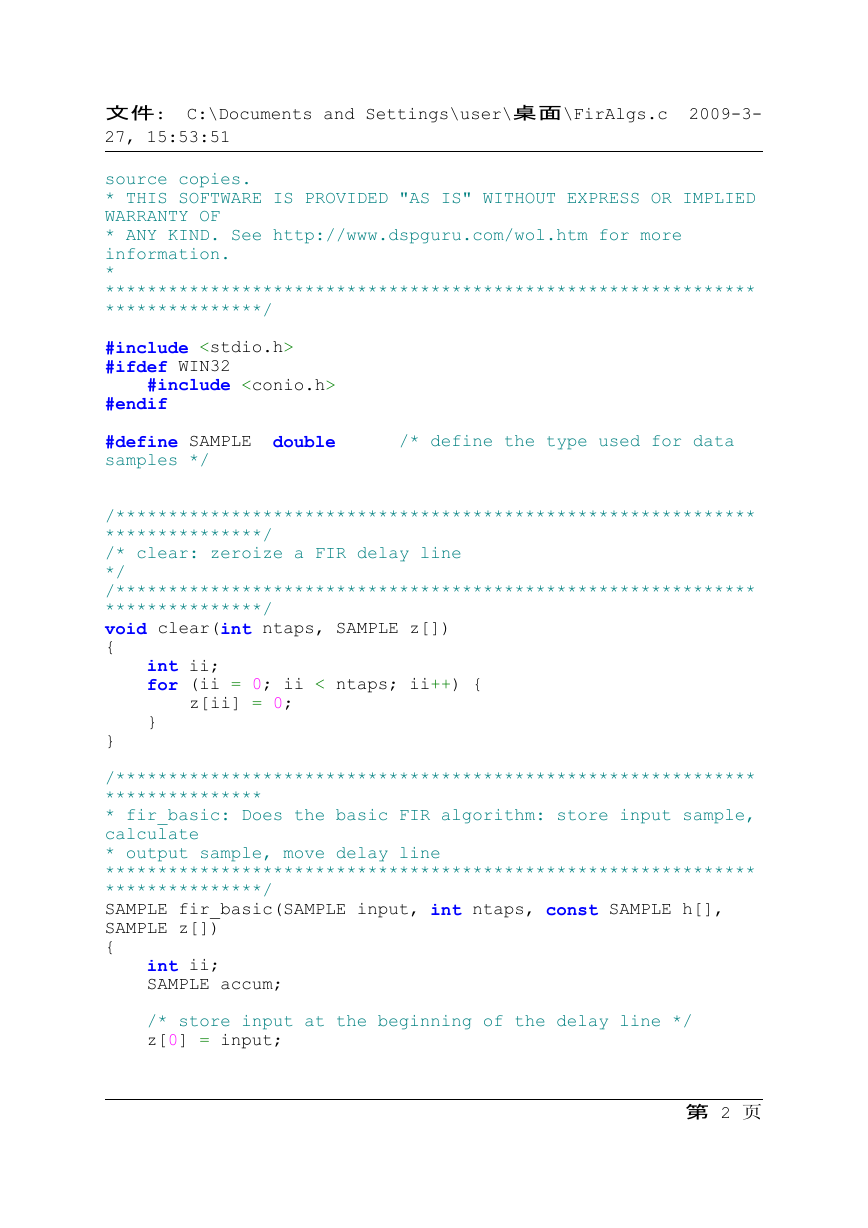
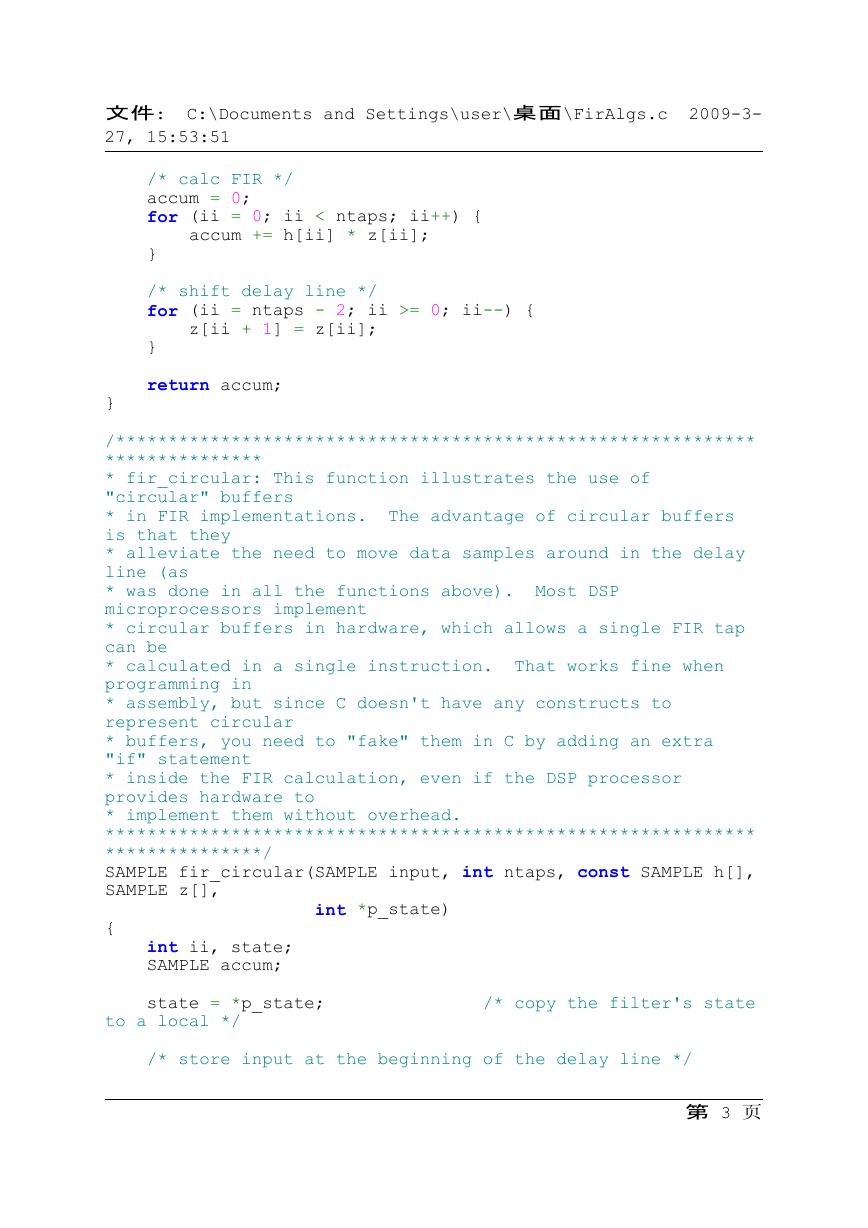
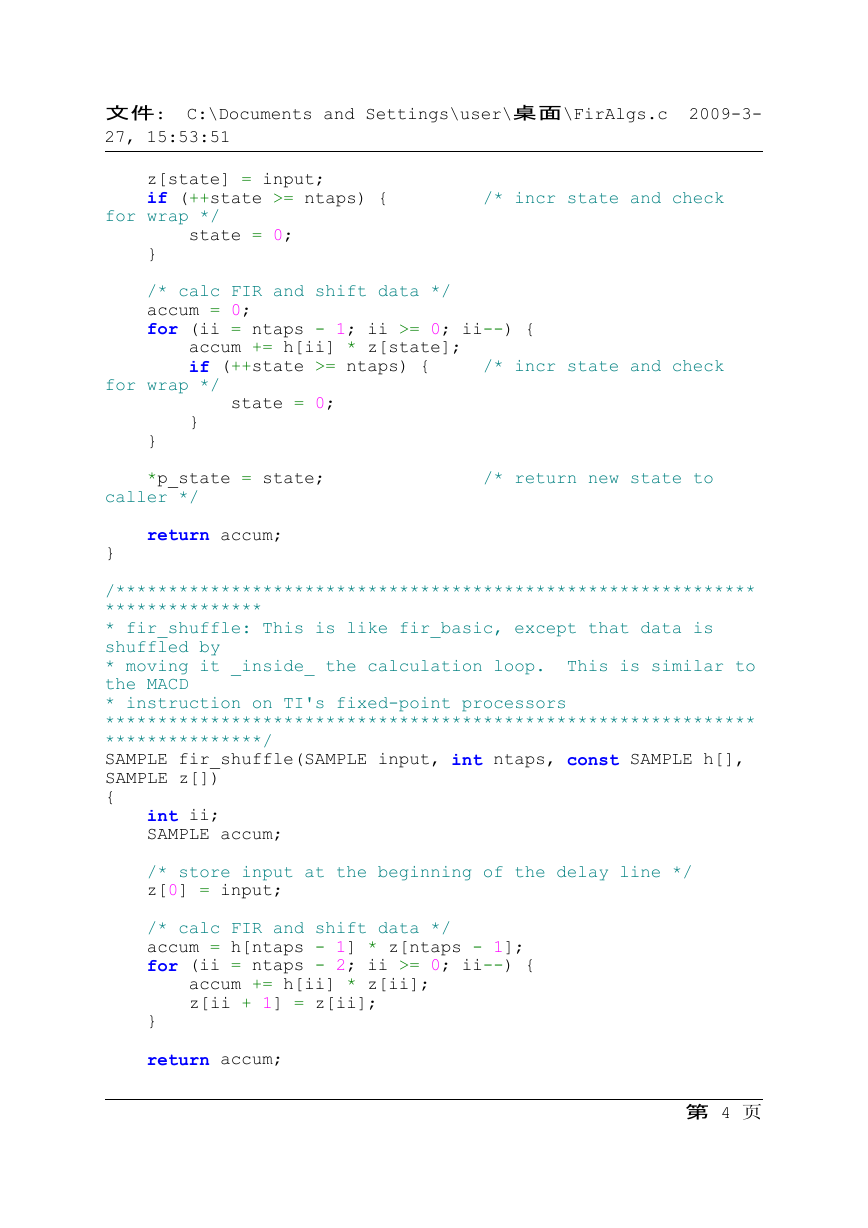
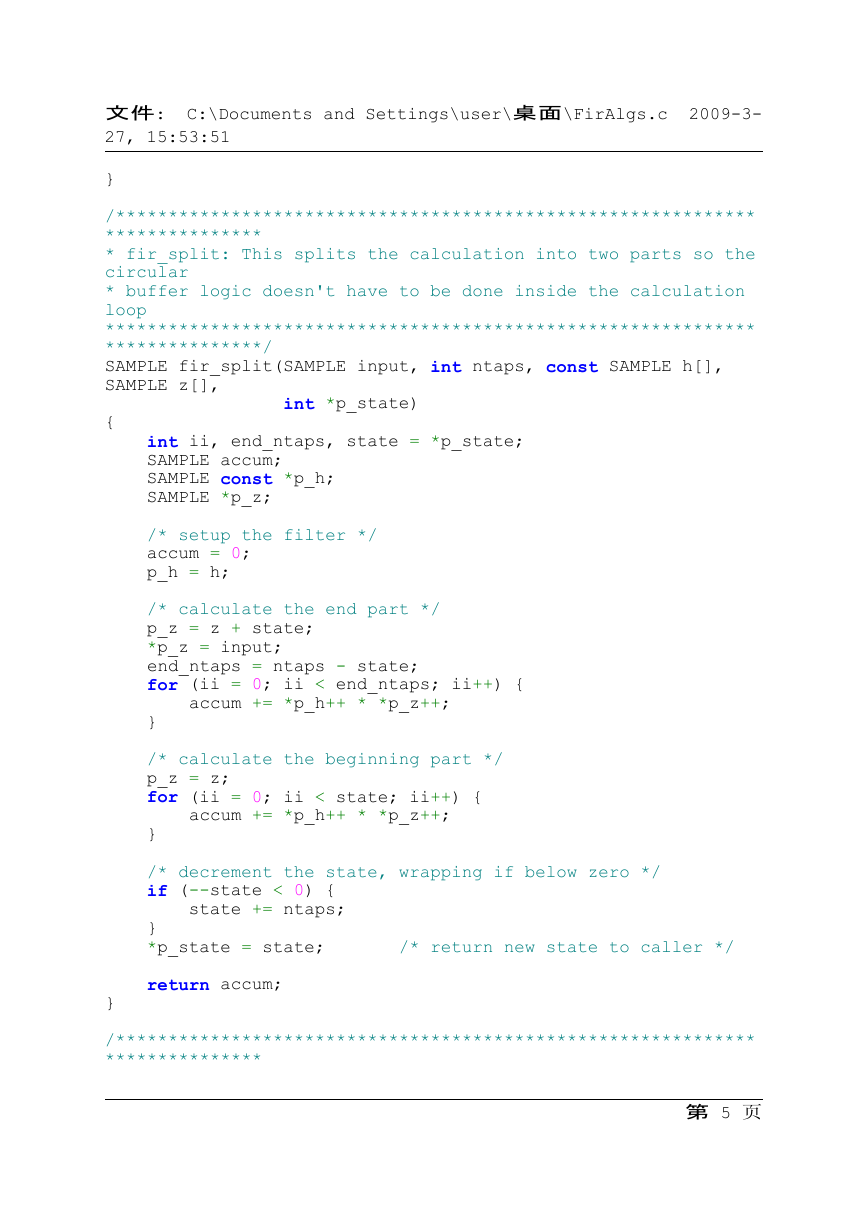
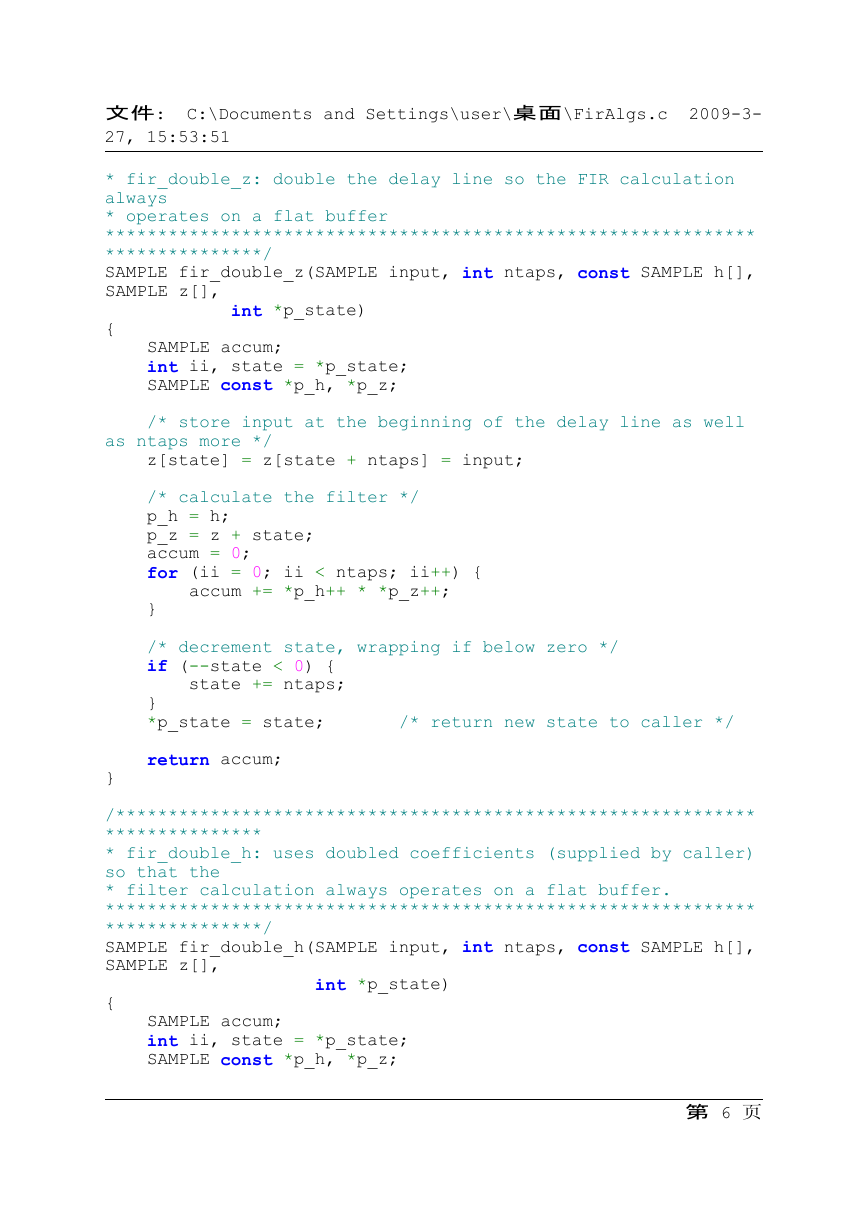
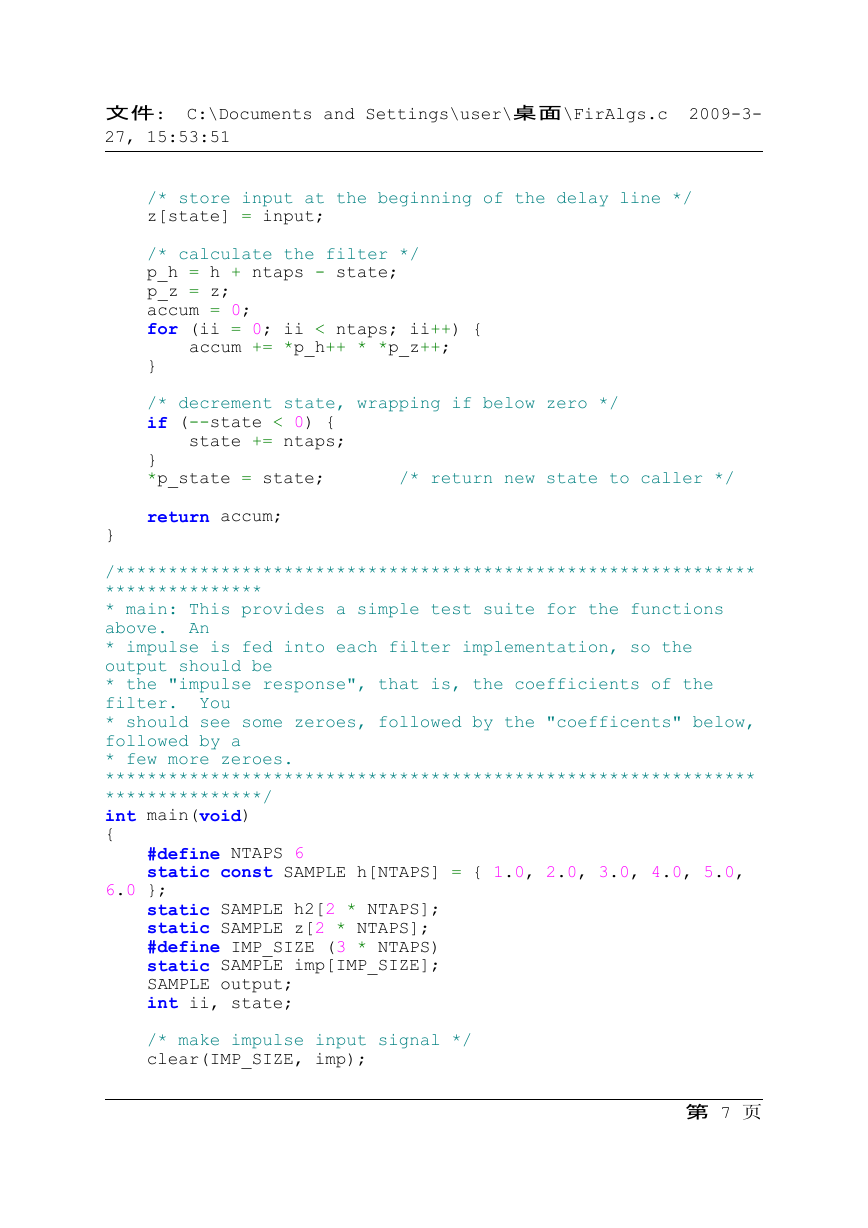
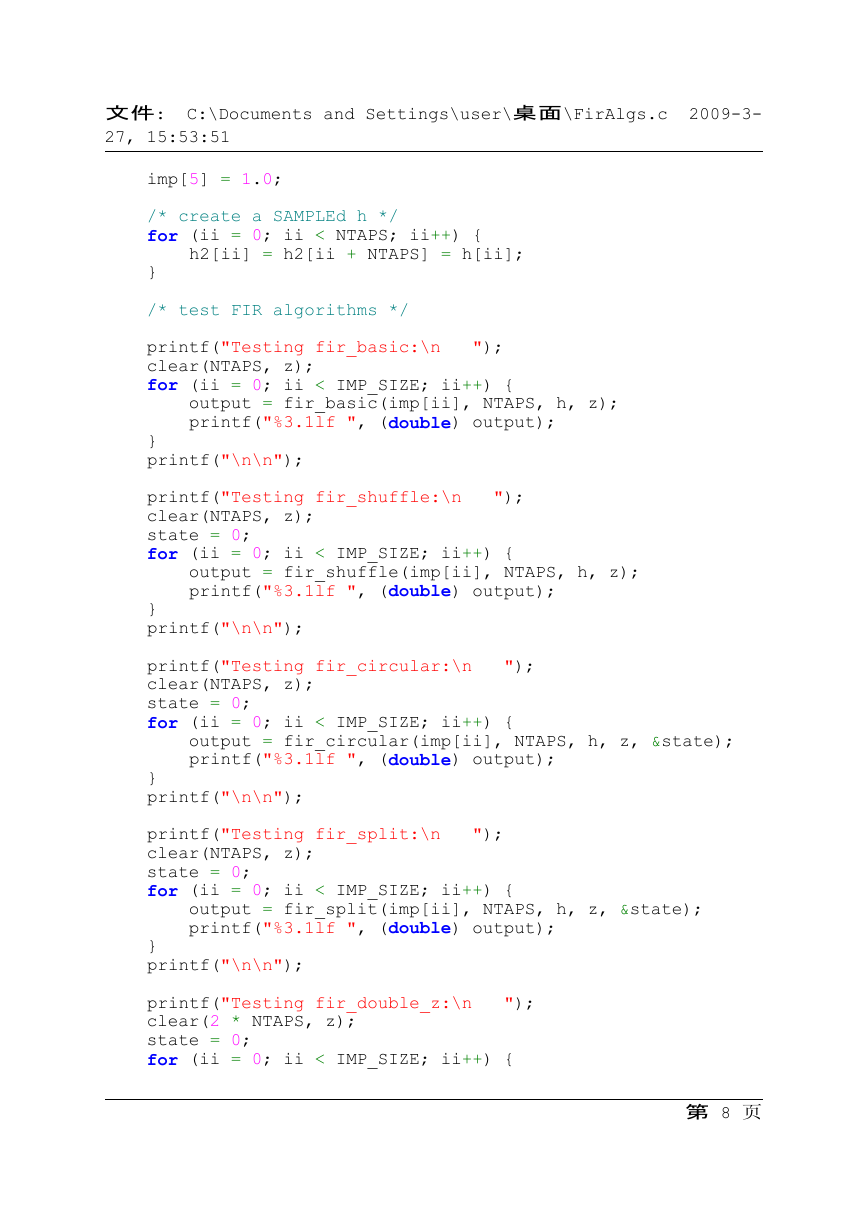








 2023年江西萍乡中考道德与法治真题及答案.doc
2023年江西萍乡中考道德与法治真题及答案.doc 2012年重庆南川中考生物真题及答案.doc
2012年重庆南川中考生物真题及答案.doc 2013年江西师范大学地理学综合及文艺理论基础考研真题.doc
2013年江西师范大学地理学综合及文艺理论基础考研真题.doc 2020年四川甘孜小升初语文真题及答案I卷.doc
2020年四川甘孜小升初语文真题及答案I卷.doc 2020年注册岩土工程师专业基础考试真题及答案.doc
2020年注册岩土工程师专业基础考试真题及答案.doc 2023-2024学年福建省厦门市九年级上学期数学月考试题及答案.doc
2023-2024学年福建省厦门市九年级上学期数学月考试题及答案.doc 2021-2022学年辽宁省沈阳市大东区九年级上学期语文期末试题及答案.doc
2021-2022学年辽宁省沈阳市大东区九年级上学期语文期末试题及答案.doc 2022-2023学年北京东城区初三第一学期物理期末试卷及答案.doc
2022-2023学年北京东城区初三第一学期物理期末试卷及答案.doc 2018上半年江西教师资格初中地理学科知识与教学能力真题及答案.doc
2018上半年江西教师资格初中地理学科知识与教学能力真题及答案.doc 2012年河北国家公务员申论考试真题及答案-省级.doc
2012年河北国家公务员申论考试真题及答案-省级.doc 2020-2021学年江苏省扬州市江都区邵樊片九年级上学期数学第一次质量检测试题及答案.doc
2020-2021学年江苏省扬州市江都区邵樊片九年级上学期数学第一次质量检测试题及答案.doc 2022下半年黑龙江教师资格证中学综合素质真题及答案.doc
2022下半年黑龙江教师资格证中学综合素质真题及答案.doc